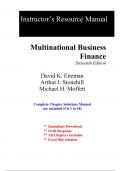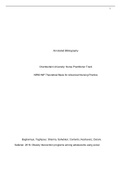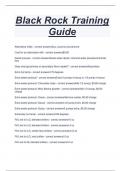Instructor’s Resource Manual
Multinational Business
Finance
Sixteenth Edition
David K. Eiteman
Arthur I. Stonehill
Michael H. Moffett
Complete Chapter Solutions Manual
are included (Ch 1 to 18)
** Immediate Download
** Swift Response
** All Chapters included
** Excel files solution
,CHAPTER 1
MULTINATIONAL FINANCIAL MANAGEMENT:
OPPORTUNITIES AND CHALLENGES
1.1 Globalization Risks in Business. What are some of the risks that come with the growing
globalization of business?
Exchange rates. The international monetary system, an eclectic mix of floating and managed fixed
exchange rates, is constantly changing. For example the growth of the Chinese yuan (or renminbi)
is now changing the global currency landscape.
Interest rates. Large fiscal deficits, including the current eurozone crisis, plague most of the major
trading countries of the world, complicating fiscal and monetary policies, and ultimately, interest
rates and exchange rates.
Many countries experience continuing balance of payments imbalances, and in some cases,
dangerously large deficits and surpluses; all will inevitably move exchange rates.
Ownership, control, and governance vary radically across the world. The publicly traded company
is not the dominant global business organization—the privately held or family-owned business is
the prevalent structure—and their goals and measures of performance vary dramatically.
Global capital markets that normally provide the means to lower a firm's cost of capital, and even
more critically, increase the availability of capital, have in many ways shrunk in size and have
become less open and accessible to many of the world's organizations.
Financial globalization has resulted in the ebb and flow of capital in and out of both industrial and
emerging markets, greatly complicating and adding volatility to financial management.
1.2 Globalization and the Multinational Enterprise (MNE). The term globalization has become widely
used in recent years. How would you define it?
Narayana Murthy’s quote is a good place to start any discussion of globalization:
“I define globalization as producing where it is most cost-effective, selling where it is most
profitable, and sourcing capital where it is cheapest, without worrying about national boundaries.”
Narayana Murthy, President and CEO, Infosys
1.3 Assets, Institutions, and Linkages. Which assets play the most critical role in linking the major
institutions that make up the global financial marketplace?
The debt securities issued by governments are low-risk or risk-free assets and form the foundation for
the creation, trading, and pricing of other financial assets like bank loans, corporate bonds, and equities
(stock). In recent years a number of additional securities have been created from the existing securities
—derivatives, whose value is based on market value changes in the underlying securities. The health
and security of the global financial system relies on the quality of these assets.
1.4 Currencies and Symbols. What technological change is even changing the symbols we use in the
representation of different country currencies?
, 2 Eiteman/Stonehill/Moffett Multinational Business Finance, Sixteenth Edition
As currency trading has shifted from verbal telephone conversations to electronic and digital trading,
currency symbols (many of which were not common across alphabetic platforms like the British pound,
£) have been replaced with the ISO-4217 codes, three-letter currency codes like USD, EUR, and GBP.
1.5 Eurocurrencies and LIBOR. Why have eurocurrencies and LIBOR remained the centerpiece of the
global financial marketplace for so long?
Eurocurrencies and LIBOR (and there are LIBOR rates for all eurocurrencies) reflect the “purest” of
market driven currencies and instrument rates. They are largely unregulated and, therefore, reflect
freely traded assets whose value is set by the daily global marketplace.
1.6 Theory of Comparative Advantage. Define and explain the theory of comparative advantage.
The theory of comparative advantage provides a basis for explaining and justifying international trade
in a model world assumed to enjoy free trade, perfect competition, no uncertainty, costless information,
and no government interference. The theory contains the following features:
Exporters in Country A sell goods or services to unrelated importers in Country B.
Firms in Country A specialize in making products that can be produced relatively efficiently, given
Country A’s endowment of one or more factors of production. that is, land, labor, capital, and
technology. Firms in Country B do likewise, given the factors of production found in Country B.
In this way the total combined output of A and B is maximized.
Because the factors of production cannot be moved freely from Country A to Country B, the
benefits of specialization are realized through international trade.
The way the benefits of the extra production are shared depends on the terms of trade, the ratio at
which quantities of the physical goods are traded. Each country’s share is determined by supply
and demand in perfectly competitive markets in the two countries. Neither Country A nor Country
B is worse off than before trade, and typically both are better off, albeit perhaps unequally.
1.7 Limitations of Comparative Advantage. Key to understanding most theories is what they say and
what they don’t. Name four or five key limitations to the theory of comparative advantage.
Although international trade might have approached the comparative advantage model during the
nineteenth century, it certainly does not today, for the following reasons:
Countries do not appear to specialize only in those products that could be most efficiently produced
by that country’s particular factors of production. Instead, governments interfere with comparative
advantage for a variety of economic and political reasons, such as to achieve full employment,
economic development, national self-sufficiency in defense-related industries, and protection of an
agricultural sector’s way of life. Government interference takes the form of tariffs, quotas, and
other non-tariff restrictions.
At least two of the factors of production, capital and technology, now flow directly and easily
between countries rather than only indirectly through traded goods and services. This direct flow
occurs between related subsidiaries and affiliates of multinational firms as well as between
unrelated firms via loans and license and management contracts. Even labor flows between
countries, such as immigrants into the United States, immigrants within the European Union, and






